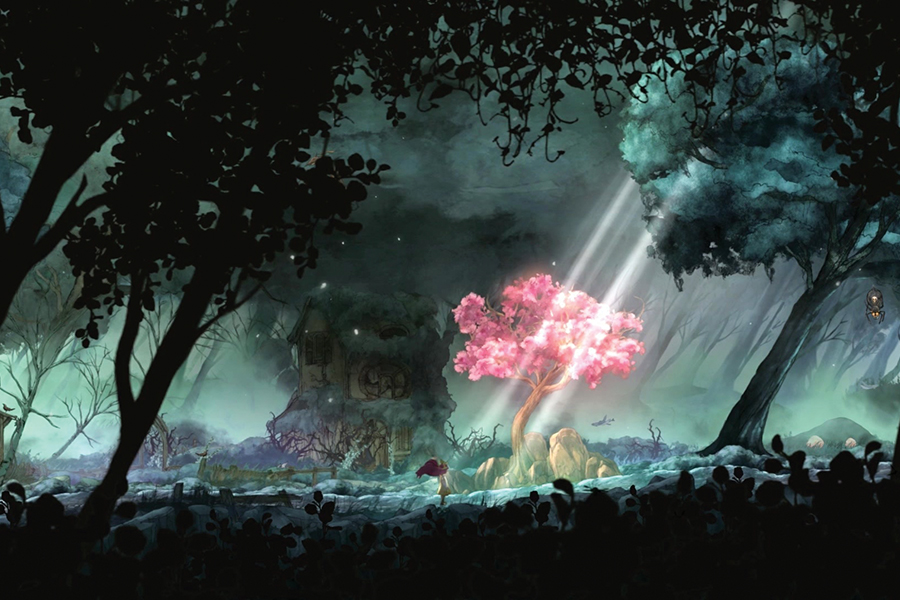
“Child of Light” is the newest RPG from developer Ubisoft Montreal that uses the UbiArt Framework, the same game engine used to create “Rayman Legends.” It is a 2D, side-scrolling RPG that adds in some minor platforming and puzzle solving to its stellar turn-based combat system, and the gameplay instantly grabs your attention with its storybook-like art style, which makes everything look like a moving painting. And coming in a modest $15 package, how great is this download-only game?
You assume the role of Aurora, a young girl who gets taken away from her castle, only to wake up alone in a foreign land. She quickly figures out that this is not a normal world; it is filled with unfriendly creatures and monsters. Aurora must find her way home to her dying father, and on her way she finds new friends who help her on her journey, the first of which is a firefly who acts not only as a friend, but also a provider of light — which becomes a necessity later on. The journey takes you to some rather quirky places, with equally as eccentric characters that make the whole experience truly feel epic.
The experience is actually a nice marriage between story and art style, which accentuates the gameplay. The colors are vibrant, and nothing on the screen ever looks boring because of the attention to detail. The creativity in the world is fantastic — you will go into a city that is perched on a giant’s back, fight smiling rocks and even join forces with a traveling jester. All of these unique ideas make it an adventure worth seeing and experiencing.
All of Ubisoft’s hard work would have been for nothing if the gameplay was no good, but surprisingly, even after all the gushing over the top presentation, it is the best part. There are three parts to the gameplay: platforming, puzzle solving and combat. It does not overwhelmingly excel in any one area, but all three aspects are good when put together to create a fun game. Aurora quickly gains wings that allow you to float around without limitations, and there are also some limited moments of platforming where you will get from one platform to another with obstacles like spikes in your way. While not very difficult, it is much more engaging than going from point A to point B with nothing to do in between. Your firefly friend comes in handy because light is utilized to solve different puzzles, and by controlling the firefly, you can use your light to create shadows that are used to solve puzzles and unlock doors, or open up chests in the far distance.
The holy grail in “Child of Light” is the combat. For the most part, it is very simple: You go into battle with two characters of your liking, and take turns between your team and the opponents. Each turn consists of choosing between attacking, defending or using potions. The magic really happens with the introduction of the combat timeline. Every time you go into battle, there is a timeline placed below the whole fight. On this timeline there are two sections: wait and cast. Every character in the battle, whether they are an ally or an enemy, is on this timeline, and once the battle starts everyone moves toward cast. This is how turns are decided — whoever gets to the end of the timeline gets to attack. Get hit by an opponent during your casting time and you get interrupted, making you essentially lose that attack — and the same goes when you attack someone while they are in their “casting” time. Each different character has a different speed on the timeline, so it becomes very important to use allies that will work best with how you plan on attacking.
As Aurora, you do have an advantage, though. Remember that friendly firefly? Well, he is with you during battle as well, but not as someone who can attack. Instead, you can shine light on an enemy (only one at a time) to slow them down on the battle timeline, or on allies to heal them. This gives you an advantage because you can manipulate enemy speed to try and accommodate whatever you are trying to do. To keep this from being too overpowered, there is a light bar which you must let recharge if overused.
The only real downside to the adventure is the length. If played just to finish the game, you can easily finish it within six hours, which is not too bad considering the price tag. It is also fairly easy, and for RPG veterans I would recommend playing on a higher difficulty the first time through. There is also very little replay value because there is not much to do other than collect new stones, but there is no incentive in that.
It is odd to see a big publisher put out a smaller game like this, but do not let the pint-size game fool you; this is one of the best games of the year. It is simple, fun and beautiful. The battle system is its highlight, but you will never be bored when looking at this game, and its incredibly reasonable price makes this a must-buy for everyone.
Rating: 4.5 stars








